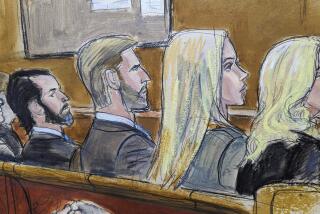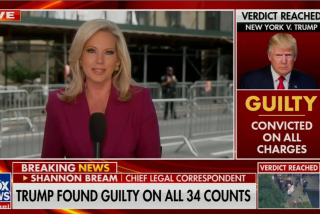Not Ready for Prime Time in U.S. Courts
- Share via
Recent television coverage of sensational trials has captured the public imagination. Yet it underscores the conflict existing between a community’s right to know and a defendant’s constitutional entitlement to a fair trial. Important state criminal cases in the nation are increasingly televised, replete with instantaneous commentary by photogenic legal experts who explain the intricacies of proceedings that may change the course of a defendant’s life. At the same time, U.S. law prohibits the use of cameras in federal courts. While greater access of broadcast media to the courtroom is desirable, recent experience in state courts suggests that removal of the federal ban would be premature.
The Federal Rules of Criminal Procedure deny federal judges any discretion in such matters. Though assailed both by defendants seeking to maximize media coverage of their trials and by broadcasters asserting the public’s First Amendment right to be informed, the federal ban is inflexibly enforced.
Federal courts have ruled that a prohibition on televising trials does not violate the First Amendment if reporters are free to attend and convey any information that they gather. The presence of cameras in court, it is argued, impairs the dignity and decorum that are essential to judicial proceedings. While broadcasters strive to enlarge their coverage of litigation, the invasion of cameras into the courtroom risks casting judges, lawyers and parties as actors. Moreover, publicity attending the intrusion of television into the judicial process may fan the flames of community indignation over a crime, threatening to deprive defendants of their constitutional right to an impartial jury and a fair trial.
But cameras need not strain court decorum. Current technology allows for quiet, unobtrusive electronic documentation and telecasting of trials. While a TV camera is a powerful weapon that can devastate an accused in the public’s eyes, the risk of impairing a jury’s impartiality is present in any publication of a trial, whether by print or broadcast. In any event, judges are fully empowered to control the manner in which the coverage is conducted.
Television is a uniquely efficient tool for distributing information to an audience hungry for visual images and sounds to complement the printed word. The cynicism and distrust that some individuals bear toward the rulings of our courts result in part from lack of familiarity with legal reasoning. The properly controlled broadcasting of trials might shed light on the troublesome perception that the judicial branch is an undemocratic institution dominated by the arcane rules of the legal intelligentsia.
The past 50 years have shown the historic and pedagogic importance of broadcasting quasi-judicial proceedings. Televised coverage of the McCarthy, Watergate and Iran-Contra hearings contributed to the nation’s understanding of the governmental process. In each of these instances there was the concomitant risk of prejudicing some current or prospective defendant’s right to an impartial trial.
In 1791, during the infancy of our Constitution, freedom of the press meant the uninhibited right to write and distribute news. Publication of the printed word was then the best way to disseminate information. Today it is often asserted that television provides a method of communicating to greater numbers of people. It also allows viewers, it is argued, to experience events with their own eyes and ears.
The architects of our Constitution did not define the scope or meaning of freedom of the press, nor did they describe the method for ensuring an impartial jury in criminal cases. These seemingly abstract and amorphous concepts were left to be adapted to modern circumstances by succeeding generations. Indeed, in a society where a majority of citizens rely on television as their source of news, it has been suggested that a ban on broadcasting any court proceeding is at odds with an evolving conception of the First Amendment. Although we are far from a consensus on this viewpoint, James Madison’s words are frequently cited: “A popular Government, without popular information . . . is but a Prologue to a Farce or a Tragedy; or, perhaps both . . . . (A) people who mean to be their own Governors, must arm themselves with the power which knowledge gives.”
We will arrive at this stage of expanded freedom of the press only if the media are afforded full opportunity to fulfill their vital function of disseminating truth, and if they exercise that prerogative with dignity and regard for other constitutional rights. Unfortunately, too often the trials that are televised seem to involve sex, drugs, violence or racial animus. And if celebrities or political figures are parties, the viewing audience expands exponentially. In this state of affairs, federal fears, not state court hopes, are realized. Television now offers much glitter but little of the educational promise that broadcasting trials can offer.
More to Read
The complete guide to home viewing
Get Screen Gab for everything about the TV shows and streaming movies everyone’s talking about.
You may occasionally receive promotional content from the Los Angeles Times.






